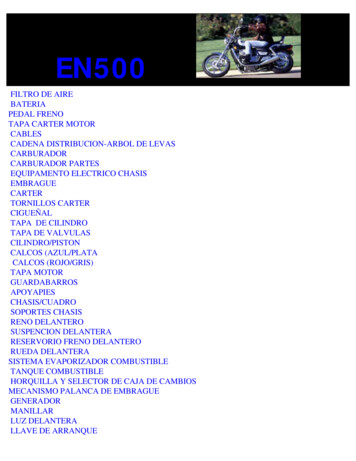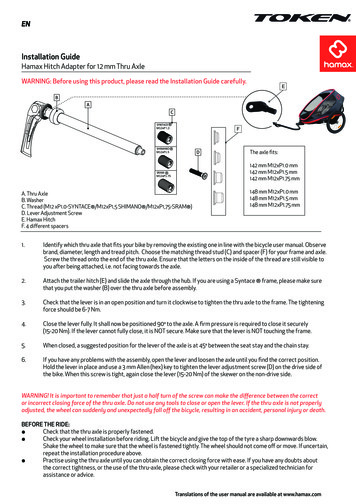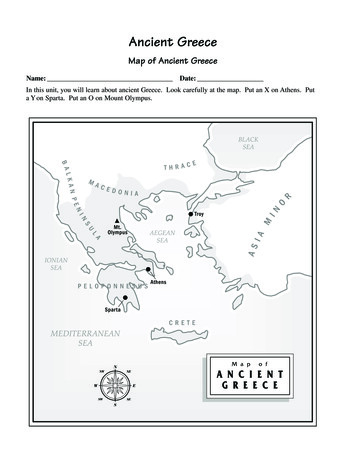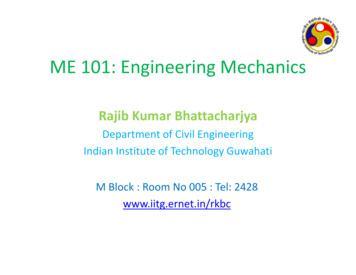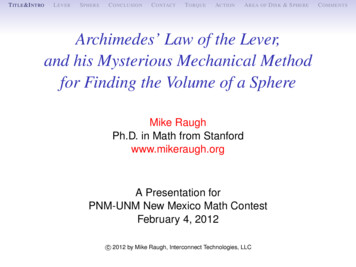
Transcription
T ITLE &I NTROL EVERS PHEREC ONCLUSIONC ONTACTT ORQUEACTIONA REA OF D ISK & S PHEREArchimedes’ Law of the Lever,and his Mysterious Mechanical Methodfor Finding the Volume of a SphereMike RaughPh.D. in Math from Stanfordwww.mikeraugh.orgA Presentation forPNM-UNM New Mexico Math ContestFebruary 4, 2012c 2012 by Mike Raugh, Interconnect Technologies, LLCC OMMENTS
T ITLE &I NTROL EVERS PHEREC ONCLUSIONC ONTACTT ORQUEACTIONA REA OF D ISK & S PHEREAttention iPad Users!The iPad renders three slides incorrectly —The ones with captions beginning:“Cylinder”, “Cone”, and “Sphere”.(Verified Mar 24, 2012)C OMMENTS
T ITLE &I NTROL EVERS PHEREC ONCLUSIONC ONTACTT ORQUEACTIONA REA OF D ISK & S PHEREArchimedes:He invented physical modelingand the mathematics needed to do it!C OMMENTS
T ITLE &I NTROL EVERS PHEREC ONCLUSIONC ONTACTT ORQUEACTIONA REA OF D ISK & S PHEREC OMMENTSLittle is known about him. Archimedes of Syracuse, 287 ? – 212 BC Greek mathematician, physicist, engineer, inventor andastronomer Approximated π, determined the area of a circle and thevolume of a sphere in terms of π Invented the compound pulley and explained themechanical advantage of the lever Laid foundations in hydrostatics and statics, calculatedarea of parabola using summation of an infinite series, anddefined the spiral of Archimedes Killed by a Roman soldier during the capture of Syracuse.
T ITLE &I NTROL EVERS PHEREC ONCLUSIONC ONTACTT ORQUEACTIONA REA OF D ISK & S PHEREC OMMENTSArchimedes and the Roman Soldier(Anon.)
T ITLE &I NTROL EVERS PHEREC ONCLUSIONC ONTACTT ORQUEACTIONA REA OF D ISK & S PHEREC OMMENTSArchimedes’ Proudest Achievement(NYU, http://math.nyu.edu/ crorres/Archimedes/Tomb/Cicero.html)The enclosed sphere has 2/3 the volume of the cylinder.In this talk we begin with the Law of the Lever, then concludewith Archimedes’ use of it to determine the volume of a sphere.
T ITLE &I NTROL EVERS PHEREC ONCLUSIONC ONTACTT ORQUEACTIONPart 1The Law of the LeverA REA OF D ISK & S PHEREC OMMENTS
T ITLE &I NTROL EVERS PHEREC ONCLUSIONC ONTACTT ORQUEACTIONA REA OF D ISK & S PHEREC OMMENTSArchimedes’ Moves the World(Anon.)“Give me a lever long enough and a place to stand and I willmove the world.”
T ITLE &I NTROL EVERS PHEREC ONCLUSIONC ONTACTT ORQUEACTIONA REA OF D ISK & S PHEREC OMMENTSArchimedes’ Law was innovative like the “Pons Asinorum”of Thales.Theorem: Base angles of an isosceles triangle are equal.Seems obvious.But Greeks wanted strictly deductive proofs based on statedaxioms — not loose arguments like donkeys prefer.Pons Asinorum, the Bridge of Asses. Theorem attributed toThales (c 624 – 526 BC).
T ITLE &I NTROL EVERS PHEREC ONCLUSIONC ONTACTT ORQUEACTIONA REA OF D ISK & S PHEREC OMMENTSThe Law of the Lever(Wikipedia)Archimedes assumed: A mass presses down on a static beamas if concentrated at its center-of-mass.The beam is stiff and weightless.
T ITLE &I NTROL EVERS PHEREC ONCLUSIONC ONTACTT ORQUEACTIONA REA OF D ISK & S PHEREC OMMENTSArchimedes invented the Center-of-Mass.(Clip Art Freeware)Where is the center-of-mass? This usually needs calculus, butArchimedes understood the concept without modern calculus.
T ITLE &I NTROL EVERS PHEREC ONCLUSIONC ONTACTT ORQUEACTIONA REA OF D ISK & S PHEREC OMMENTSThe Axiom of EquivalenceA distributed mass balances like the same massconcentrated at its center-of-mass.This is an empirical fact not deducible fromgeometry.The Law of the Lever rests on the concept ofcenter-of-mass.
T ITLE &I NTROL EVERS PHEREC ONCLUSIONC ONTACTT ORQUEACTIONA REA OF D ISK & S PHEREC OMMENTSArchimedes’ Proof of the Law of the leverprf.htm)To find a balance point between two weights, divide them intocommensurable units, colored red and blue. Place the unitsuniformly on a beam; the balance point is at the center of theunits. The proportionate distances are measured from thecenter of the units, 3 : 5 in this case. So, 5 x 3 3 x 5.
T ITLE &I NTROL EVERS PHEREC ONCLUSIONC ONTACTT ORQUEACTIONA REA OF D ISK & S PHEREC OMMENTSArchimedes’ InnovationsArchimedes:1. invented the concept of center-of-mass;2. introduced a rigorous mathematical model to describe aphysical phenomenon: the Law of the Lever;3. applied his law of the lever to find the volume of a sphere— this was the mysterious Mechanical Method he referredto in his correspondence with other geometers-
T ITLE &I NTROL EVERS PHEREC ONCLUSIONC ONTACTT ORQUEACTIONA REA OF D ISK & S PHEREC OMMENTSAxioms for Center-of-Mass for AreasAxyBArchimedes generalized the Law of the Lever. Figure illustratestwo axioms for balancing areas in 2D:(Area A) · x (Area B) · yThird axiom: center-of-mass of a convex area lies within thearea.Archimedes used these in his theory of bouyancy.See Stein in Recommended reading.
T ITLE &I NTROL EVERS PHEREC ONCLUSIONC ONTACTT ORQUEACTIONA REA OF D ISK & S PHEREC OMMENTSThe Modern Definition of Center-of-MassGiven point-masses {(mi , xi ), i 1, . . . , n}, their center of massX, also called centroid, is definedPnmi xiX Pi 1ni 1 miMore generally,RxdmX RVV dmThese vector equations, which yield the balance point for amass distribution in 1-D, generalize the Law of the Lever. In 3-Dthey are fundamental constructs of rigid-body mechanics.
T ITLE &I NTROL EVERS PHEREC ONCLUSIONC ONTACTT ORQUEACTIONA REA OF D ISK & S PHEREC OMMENTSThe Law of the Lever(Wikipedia)
T ITLE &I NTROL EVERS PHEREC ONCLUSIONC ONTACTT ORQUEACTIONA REA OF D ISK & S PHEREPart IIVolume of the SphereArchimedes’ Method, unknown until 1906,applies the Law of the Lever.C OMMENTS
T ITLE &I NTROL EVERS PHEREC ONCLUSIONC ONTACTT ORQUEACTIONA REA OF D ISK & S PHEREC OMMENTSArchimedes explained his “Mechanical Method” in aPalimpsest discovered in 1906 in a Byzantine Crypt inIstanbul.( c The Owner of the Palimpsest)Here’s what it looked like when rediscovered in 1998.
T ITLE &I NTROL EVERS PHEREC ONCLUSIONC ONTACTT ORQUEACTIONA REA OF D ISK & S PHEREC OMMENTSOne Imaged Page of the Archimedes Palimpsest(Wikipedia)In the early 1900s, the Danish philologist Johan Heibergtranscribed legible portions into Greek. Here is a recent scan.
T ITLE &I NTROL EVERS PHEREC ONCLUSIONC ONTACTT ORQUEACTIONA REA OF D ISK & S PHEREC OMMENTSArchimedes used the Law of the Lever to compare volumesof a cylinder, cone and sphere.Archimedes knew the volumes of cylinders and cones. andareas of their circular cross sections. He used these todetermine the volume of the sphere.
T ITLE &I NTROL EVERS PHEREC ONCLUSIONC ONTACTT ORQUEACTIONA REA OF D ISK & S PHERECylinder: Area of x-level Cross SectionxCircular cross-sectionat level x: 4πr 2[Volume of cylinder Cy 8πr 3 ]2r2rC OMMENTS
T ITLE &I NTROL EVERS PHEREC ONCLUSIONC ONTACTT ORQUEACTIONA REA OF D ISK & S PHERECone: Area of x-level Cross Section2rx2rCircular cross-section at level x:[Volume of cone Co 38 πr 3 ]πx 2C OMMENTS
T ITLE &I NTROL EVERS PHEREC ONCLUSIONC ONTACTT ORQUEACTIONA REA OF D ISK & S PHERESphere: Area of x-level Cross Sectionxsrr-xCircular cross-section at level x:2rπs2 2πrx πx 2[Volume of sphere S ?]C OMMENTS
T ITLE &I NTROL EVERS PHEREC ONCLUSIONC ONTACTT ORQUEACTIONA REA OF D ISK & S PHEREC OMMENTSMethod (Step 1): Three Solids in Perfect BalancerxxxWe will see that the x-level cross sections balance. (Assuminguniform density.)
T ITLE &I NTROL EVERS PHEREC ONCLUSIONC ONTACTT ORQUEACTIONA REA OF D ISK & S PHEREC OMMENTSMethod (Step 2): The cross-section (CS) areas balance.2rxCone CS:Sphere CS:x-rrsxx πx 2 ;πs2 2πrx πx 2 ;(Cone CS Sphere CS) 2πrxCylinder CS: 4πr 22r · (Cone CS Sphere CS) 4πr 2 x Cylinder CS · xQED
T ITLE &I NTROL EVERS PHEREC ONCLUSIONC ONTACTT ORQUEACTIONA REA OF D ISK & S PHEREMethod (Step 3): The Derivationxxxx2rBy previous slide: Each x-section of cylinder balances thecombined x-sections of the hanging cone and sphere.Therefore, the volumes balance: 2r · (Co S) r · Cy , soCo 8 3πr ,3Cy 8πr 3 S 4 3πr3C OMMENTS
T ITLE &I NTROL EVERS PHEREC ONCLUSIONC ONTACTT ORQUEACTIONA REA OF D ISK & S PHEREUsing modern terms, we would express this as:2r (Co S) Z2r4Z(2r )(2πrx)dx 8πr 02r(x)(4πr 2 )dx0 rCyArchimedes did this nearly 2 millenia before Newton andLeibniz.C OMMENTS
T ITLE &I NTROL EVERS PHEREC ONCLUSIONC ONTACTT ORQUEACTIONA REA OF D ISK & S PHEREC OMMENTSArchimedes’ Proudest AchievementArchimedes asked that a cylinder and sphere be mounted onhis tomb, displaying their proportional volumes.The sphere is 2/3 the volume of a circumscribed cylinder:4S πr 3 .3
T ITLE &I NTROL EVERS PHEREC ONCLUSIONC ONTACTT ORQUEACTIONA REA OF D ISK & S PHEREC OMMENTS“Cicero discovering the Tomb of Archimedes – 1”(Anon., 1806)Frontispiece of Weinzierl’s German translation of Cicero’sTusculan Disputations
T ITLE &I NTROL EVERS PHEREC ONCLUSIONC ONTACTT ORQUEACTIONA REA OF D ISK & S PHEREC OMMENTS“Cicero discovering the Tomb of Archimedes – 2”(Martin Knoller (1725-1804))
T ITLE &I NTROL EVERS PHEREC ONCLUSIONC ONTACTT ORQUEACTIONA REA OF D ISK & S PHEREC OMMENTS“Cicero discovering the Tomb of Archimedes – 3”(Benjamin West (1738-1820))
T ITLE &I NTROL EVERS PHEREC ONCLUSIONC ONTACTT ORQUEACTIONA REA OF D ISK & S PHEREC OMMENTS“Cicero discovering the Tomb of Archimedes – 4”(Hubert Robert (1733-1808))
T ITLE &I NTROL EVERS PHEREC ONCLUSIONC ONTACTT ORQUEACTIONA REA OF D ISK & S PHEREC OMMENTS“Ciceron Decouvrant le Tombeau d’Archimede” – 5(Pierre Henri de Valenciennes (1750-1819))
T ITLE &I NTROL EVERS PHEREC ONCLUSIONC ONTACTT ORQUEACTIONA REA OF D ISK & S PHEREC OMMENTSConclusionArchimedes invented physical modeling, using rigorousmathematical deductions from specified physical axioms.He formulated and proved the Law of the Lever, based oncenter-of-mass.He anticipated methods of integral calculus: Cavalieri’sPrinciple and Fubini’s theorem.And now we know his Mechanical Method, by which he appliedthe Law of the Lever to determine the volume of a sphere.
T ITLE &I NTROL EVERS PHEREC ONCLUSIONC ONTACTT ORQUEACTIONA REA OF D ISK & S PHEREC OMMENTSRecommended reading Asger Aaboe, Episodes from the early history of mathematics, Mathematical Association of America, 1998.Archimedes, The works of Archimedes, DoverPublications, (Thomas L. Heath edition), 2002.E. J. Dijksterhuis, Archimedes, Acta Historica ScientiarumNaturalium et Medicinalium, vol 12, 1956.Laubenbacher and Pengelley, Mathematical Expeditions —Chronicles by the Explorers, Springer, 1999.Sherman Stein, Archimedes: What Did He Do Besides CryEureka? Mathematical Association of America, 1999. Nietz & Noel, The Archimedes Codex: How a MedievalPrayer Book Is Revealing the True Genius of Antiquity’sGreatest Scientist, Da Capo Press, Jan 9, 2009. The Archimedes Palimpsesthhttp://www.archimedespalimpsest.org/i
T ITLE &I NTROL EVERS PHEREC ONCLUSIONC ONTACTT ORQUEACTIONA REA OF D ISK & S PHEREC OMMENTSIn the Endnotes, the slides continue with:An alternative discussion of the Law of theLever using the concept of torque,A sketch of Archimedes’ derivation of thesurface area of a disk (πr 2 ) and a sphere (πD 2 )andBrief commentary.
T ITLE &I NTROL EVERS PHEREC ONCLUSIONC ONTACTT ORQUEACTIONA REA OF D ISK & S PHEREC OMMENTSA text version with more details will be available on my web.These slides are there, too:www.mikeraugh.orgContact me at,Michael.Raugh@gmail.com(Supplementary sections follow.)
T ITLE &I NTROL EVERS PHEREC ONCLUSIONC ONTACTT ORQUEACTIONA REA OF D ISK & S PHEREC OMMENTSEndnote 1Torque is defined and determined using adifferential equation based on the Axiom ofEquivalence.The Law of the Lever is inferred.Concludes with discussion of “action at adistance” compared to “argument from cause”,with compound pulley as example.
T ITLE &I NTROL EVERS PHEREC ONCLUSIONC ONTACTT ORQUEACTIONA REA OF D ISK & S PHEREFirst, Some Balance AxiomsThese axioms are assumed in the following derivations. Theyare not the same as Archimedes’ axioms:1. (Basic) Equal masses at equal distances are balanced.2. (Symmetry) Balanced masses remain balanced underreflection about the fulcrum.3. (Linearity) A balanced set of masses added to (orsubracted from) a balanced set of masses remainsbalanced.4. (Equivalence) A distributed mass balances like the samemass concentrated at the center-of-mass.C OMMENTS
T ITLE &I NTROL EVERS PHEREC ONCLUSIONC ONTACTT ORQUEACTIONA REA OF D ISK & S PHEREWe begin with a graphic depiction of “torque.”The red, brown,and green weightsall counterbalancethe same blueweight. They exertthe same "torque",defined as the blueweight.x01C OMMENTS
T ITLE &I NTROL EVERS PHEREC ONCLUSIONC ONTACTT ORQUEACTIONA REA OF D ISK & S PHEREC OMMENTSWe compute “torque” by solving a simple differentialequation.Let t(x) be the torque exerted by 1 unit of weight at a distanceof x units from the fulcrum. By Axiom of Equivalence:xt(x)1/2x hx-ht(x h) t(x h) t(x) 2t(x h) 2t(x) t(x h)d2 t(x) 0h2dx 2h 0 t(x) ax b xlim
T ITLE &I NTROL EVERS PHEREC ONCLUSIONC ONTACTT ORQUEACTIONA REA OF D ISK & S PHERENow we have a formula for “big-T” Torque.By the Axiom of Linearity the torque exerted by an arbitraryforce F at a distance x from the fulcrum is F · t(x) F · xA force of weight W applied at a distance x from the fulcrumexerts a torque ofT (W , x) W · t(x) W · xC OMMENTS
T ITLE &I NTROL EVERS PHEREC ONCLUSIONC ONTACTT ORQUEACTIONA REA OF D ISK & S PHERELaw of the Lever: A Proof with One WordW1 · x1 Torque W2 · x2C OMMENTS
T ITLE &I NTROL EVERS PHEREC ONCLUSIONC ONTACTT ORQUEACTIONA REA OF D ISK & S PHEREC OMMENTS“Action at a Distance” vs “Argument from Cause”Archimedes avoided specifying cause; he did not explain how torqueis transmitted through a lever. Instead he assumed the mutualinfluence of objects balanced on a beam according to the empiricalAxiom of Equivalence, as likewise Newton based gravitation theoryon observed behavior, avoiding hypotheses about the cause ofattraction. Let’s call this kind of unexplained force “action at adistance.”We can incorporate cause into the derivation of torque by using theparallelogram law for composition of forces, as outlined in the nextslide. The parallelogram law is itself an empirically derived axiom,developed by Stevins, Roberval and Newton. (Rene Dugas, “AHistory of Mechanics,” Dover Edition, 1988.)Consider the beam as a material object that transmits pressure andtension. In the next slide, a triangle is used as example, wherein thehypotenuse (think wire) transmits tension, and the lower longitudinalleg of the triangle (think rod) transmits pressure. Torque T W · xabove the fulcrum results from loading the beam with force W .
T ITLE &I NTROL EVERS PHEREC ONCLUSIONC ONTACTT ORQUEACTIONA REA OF D ISK & S PHEREC OMMENTSArchimedes Assumed Action at a Distance,But a Causal Proof is Possiblew1WTxwSuppose lever is triangular, loaded with weight W at lever’s end.Resolve force (W ), where torque component isT . By similartriangles: T W · xNote that the downward load at fulcrum is also W .The same argument generalizes to a beam constructed as atruss, where x then is the length of the truss.
T ITLE &I NTROL EVERS PHEREC ONCLUSIONC ONTACTT ORQUEACTIONA REA OF D ISK & S PHEREC OMMENTSCompound Pulley: Archimedes’ Other Form of “Leverage”Assuming tension in rope is uniform, mechanical advantage iscounted by number of segments pulling on load: 5 times in leftpanel, 6 times on right (at a cost of having to pull that muchfarther). Here the cause is self-evident: force transmittedthrough rope.
T ITLE &I NTROL EVERS PHEREC ONCLUSIONC ONTACTT ORQUEACTIONA REA OF D ISK & S PHEREC OMMENTSEndnote 2Archimedes’ derivation of the area of a disk issketched.His analogous argument for determing thesurface of a sphere is described.
T ITLE &I NTROL EVERS PHEREC ONCLUSIONC ONTACTT ORQUEACTIONA REA OF D ISK & S PHEREC OMMENTSSurface Area of a Sphere — First the Disk(UBC Calculus Online, www.ugrad.math.ubc.ca)Archimedes deduced disk Area as limit of n inscribed triangles: 1 2πr(as n ) h r , and nh πr 2 Area2 n
T ITLE &I NTROL EVERS PHEREC ONCLUSIONC ONTACTT ORQUEACTIONA REA OF D ISK & S PHEREC OMMENTSSurface Area of a Sphere — Archimedes’ IdeaSame idea as for the disk:Imagine a sphere as comprised of many thin cones with apexesat the center and bases at the surface. Say, a spherical planetplatted with one-acre plots; the surface area would equal thenumber of plots.Summing the conical volumes, in the limit they amount to acone with base equal to the surface of the sphere S and heightequal to the radius r .4 3 1πr rS33 S 4πr 2
T ITLE &I NTROL EVERS PHEREC ONCLUSIONC ONTACTT ORQUEACTIONA REA OF D ISK & S PHEREEndnote 3Brief Comments Interpolated in TalkC OMMENTS
T ITLE &I NTROL EVERS PHEREC ONCLUSIONC ONTACTT ORQUEACTIONA REA OF D ISK & S PHEREC OMMENTSQuality of Archimedes’ Work“In weightiness of matter and elegance of style, no classsicalmathematics treatise surpasses the works of Archimedes. Thiswas recognized in antiquity; thus Plutarch says of Archimedes’works:‘It is not possible to find in all geometry more difficultand intricate questions, or more simple and lucidexplanations. Some ascribe this to his genius; whileothers think that incredible effort and toil producedthese, to all appearances, easy and unlabouredresults.’ ”(Aaboe in Recommended reading)
T ITLE &I NTROL EVERS PHEREC ONCLUSIONC ONTACTT ORQUEACTIONA REA OF D ISK & S PHEREC OMMENTS“Archimedes is so clever that sometimes I think that if you wantan example of someone brought from outer space it would beArchimedes. Because he, in my view, is so original and soimaginative that I think he is better than Newton. WhereasNewton said, ‘I have only seen so far because I have beenstanding on the shoulders of other giants,’ there was nobody forArchimedes, nobody’s shoulders for Archimedes to stand on.He is the first physicist and the first applied mathematician. Andhe did it all on his own from nowhere.”(Lewis Wolpert in On Shoulders of Giants by Melvyn Bragg, 1998)
T ITLE &I NTROL EVERS PHEREC ONCLUSIONC ONTACTT ORQUEACTIONA REA OF D ISK & S PHEREC OMMENTSArchimedes’ “Method of Mechanical Theorems.”Archimedes’ geometric proof for the volume of a sphere waswell known, but the method by which he discovered the resultremained a mystery until 1906.The Archimedes Palimpsest, in which Archimedes describedhis method, was found in Istanbul in a Byzantine crypt, then lostand recovered again in 1998.The Palimpsest contained a tenth-century copy of a Greek MSthat was scraped, washed and overlaid with Christian liturgyand other writings.(See Recommended reading)
T ITLE &I NTROL EVERS PHEREC ONCLUSIONC ONTACTT ORQUEACTIONA REA OF D ISK & S PHEREC OMMENTSThe Roman orator Cicero found the Archimedes’ tomb.Archimedes was killed in 212 BC.Archimedes had asked that a cylinder and sphere be mountedon his tomb, displaying their proportional volumes: 2/3.The tomb was built and lost until the figures of the cylinder andthe sphere enabled Cicero to find it 137 years later.Cicero found the tomb in 75 BC. He wrote: “So one of the mostfamous cities in the Greek world would have remained in totalignorance of the tomb of the most brilliant citizen it had everproduced, had a man from Arpinum not come and pointed itout!”(Aaboe in Recommended reading)
PNM-UNM New Mexico Math Contest February 4, 2012 c 2012 by Mike Raugh, Interconnect Technologies, LLC. TITLE&INTRO LEVER SPHERE CONCLUSION CONTACT TORQUE ACTION AREA OF DISK & SPHERE COMMENTS Attention iP

